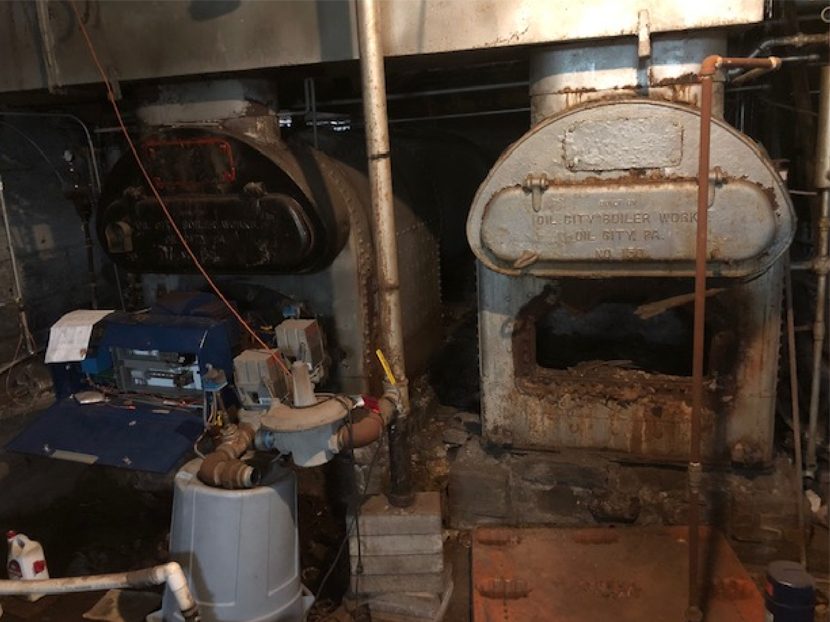My Kind of Town, Chicago Is
The story of a boiler, a tricky problem with an elusive answer and the help of a knowledgeable friend.

Wrigley Field, the Chicago Bulls who ruled the 1990s NBA, Dick Butkus, the Chicago Blackhawks winning Stanley Cups in ’10, ’13 and ’15, corrupt politicians, Union Station, diverse neighborhoods, an awesome skyline, the Belushi Brothers, Mike Royko — and boilers, boilers and more boilers. I’m not kidding. There are boilers everywhere in Chicago. It is, in fact, boiler paradise.
I’m guessing New York City may have more boilers. But I’ve driven in NYC. It’s worse than Boston. Where do you park a service truck in Manhattan? Seriously. I can usually get from my truck to the boiler room in 100 steps or less in Chicago. Ask any service tech if that’s important.
I’ve had the pleasure of working here my entire career and until just recently, I was getting my hands dirty, my knuckles bruised and my head banged into century-old, 4-inch black iron piping more times than I can remember. You’d think I would’ve started wearing a hard hat earlier than I did.
Chicago is a blue-collar town if ever there was one. And in the bowels of the old churches and apartment buildings are Kewanee, Pacific, Cleaver-Brooks and other antiquated boilers — often wrapped in brick or asbestos or a combination thereof. Many have been decommissioned, replaced and left in the room because of the often-prohibitive cost of removing them.
Those are the ones that interest me most. I no longer use the tools but my eyes, ears and imagination are working overtime. If only these mechanical rooms and boilers could talk. Well, they do. They always have. At least, to me they have. Everything in the mechanical room is part of the story and often plays a role in the proper functioning of the equipment. Here’s one of my experiences.
Challenging CO problem
Recently, I was asked to look at a Smith, 10-section, cast-iron steam boiler fitted with a power burner. It was a pretty good-sized apartment building on the south side of the city; the Kenwood neighborhood, I believe. The owner of the building was complaining of high gas bills going back to the boiler’s installation two years ago. He hired a heating contractor to clean and tune the boiler — but even after the boiler was cleaned, the carbon monoxide content on the flue gas analysis was topping out at a whopping 2,000-plus ppm. Wow! Right?
So, I meet the contractor at the site and I ask him to check static and dynamic gas pressure. Check.
I then ask him where the boiler is getting combustion air from. He shows me an ample-sized motorized damper on the other side of the room. Check.
We start up the boiler again and I ask him to break out his analyzer and insert the probe once it ramps up to high fire. I sure as Hades wasn’t going to use my Testo 320 on a boiler that wants to kill it. Unless, of course, I had to.
Within 15 seconds or so, we’re climbing northward of 2,300 ppm CO. I shut the boiler off immediately to minimize risk and save his analyzer from more, unnecessary abuse. By the way, the low-level CO sensor I wear on my belt held at 0 ppm. We’re safe for now but there’s definitely something amiss here.
Gas pressure is rock solid and meets the burner’s specifications. I double-check the free-space size of the motorized damper and we’re good there, too. I like to keep things simple. If we had the right amount of air and the right amount of gas, for all intents and purposes, we shouldn’t be having this issue but, yet, there ‘tis.
I like being challenged and I certainly feel challenged here. But might I be on to something? I’ve been walking around the room scratching my head, thinking of seemingly ridiculous possibilities of what might be the culprit for the bad burn we’re getting. And then I saw it; a monstrosity of a Kewanee boiler sitting right next to the newer Smith boiler. And its flue breeching is wholly connected to the same flue breeching as the Smith.
It’s not right or necessary. Why didn’t the installers cut loose and cap the flue pipe same as they did for the rest of the old boiler piping?
I wander over to the front of this beautiful old beast of a boiler and put my hand up against its massive iron doors; Kewanee, in big, bold letters across its width. I didn’t need a sophisticated test instrument to know that there’s a negative being pulled through these doors. I pop one of them open and its sucking like a new 5 horsepower shop vac. I’m lucky I wasn’t wearing a hat because I would’ve lost it.
This has got to be the reason we’re not getting the right air/gas mixture. It’s so obvious. We have an old leaky, atmospheric boiler connected to the same 60-foot stack as the new power-burner boiler. Chimney effect on steroids, if you will. The new boiler is being robbed of the air it needs. Only so much air is available to share and the Smith isn’t getting what it needs. All we have to do is separate the two and we’re back in the proper firing burner business.
Yes! Another mystery solved. It’s why they pay us the big bucks.
The heating contractor, his two guys and I start looking for a spot to cut and separate the flue. It sounds easy but the flue coming off the Kewanee boiler is roughly 24 inches square. I’m looking for that sweet spot when I see it. No, not the place where we should cut, but the spot where a large, heavy plate of steel was slid into the 24-inch breeching and welded in place.
I’m not sure how they did it, or why they did it that way, but I do know this: The two boiler flues are separated.
I’m an hour or two into this and I don’t have an answer yet, but I’m not discouraged. As I said, I like challenges. It’s just an air and natural gas thing. The boiler is a big one, but the principle is the same. We have too much of one, gas, and not enough of the other, air. How hard can it be? The gas pressure is spot on and the air is more than sufficient. The only thing causing it to overfire now is the wrong orifice or no orifice. It can’t be that. Right?
The burner orifice
That’s when I get the best idea I’ve had in a long time. I call a guy who’s infinitely smarter than I am. I have 38 years of experience, but he has 58 years of experience. Yes, he’s really old. And very wise. There’s not much he hasn’t seen. If you say you don’t know anyone smarter than yourself, you’re not only wrong, you’re delusional.
I tell my pal and mentor what’s going on and he agrees that we’ve taken all the right steps so far and have been as thorough as one could be. He’s proud. He’s taught me a lot through the years. And then, this.
“Have you checked the orifice?” he asks.
“I thought of that, but haven’t done it yet,” I reply
“Well, why not?” he asks.
“It can’t be the orifice,” I say.
“What else can it be?” he replies.
“You think I should check it?” I ask.
“Yes, I think you should check it. Why else would I bring it up?” he replies.
“OK,” I say, “it’s easy enough to do on this power burner, so I’ll give it a look.”
“That’d be great,” he says.
It is easy, probably easier than checking an orifice on a residential boiler. On the gas train, a 2-inch plug is on the run of a 2-inch tee that you spin off; the orifice will be staring you right in the face. As soon as I shine my flashlight on it, I’m 99.9 percent certain it is the problem. Curl your index finger over until its tip hits the tip of your thumb. That’s roughly the size of the orifice I was looking at.
I pulled it out and called the number into the factory. It turns out the installing company used a burner orifice about twice the size that it should have been. The installers obviously never did a combustion analysis at start-up.
The manufacturer ships the properly sized orifice overnight and it goes in as easily as the old one came out. We start the boiler up and I use my analyzer to see how the numbers are doing. We used mine because I have a Testo 320 analyzer and the contractor uses something far inferior. Plus, I’m confident my analyzer won’t be in harm’s way; otherwise, we’d be using his. It’s the Chicago way. Ask Sean Connery.
Just as sure as my pal is smarter than me, the combustion numbers look better than a Jon Lester fist bump after going seven strong innings. Again.
All in all, I’d call it a win. We solved a large, unusual problem the first time out. “We” being the operative word. Don’t be afraid to pick up the phone to ask a colleague a question or to bounce something off them. Sometimes the best thing to know is the right person to call. It’s not about having all the answers, but rather knowing where to find them.
I’ve got tons of Chicago boiler stories; the good, the bad and the ugly. Let me know if you want to hear more and I’ll get right on it. Me and my Chicago pals.





